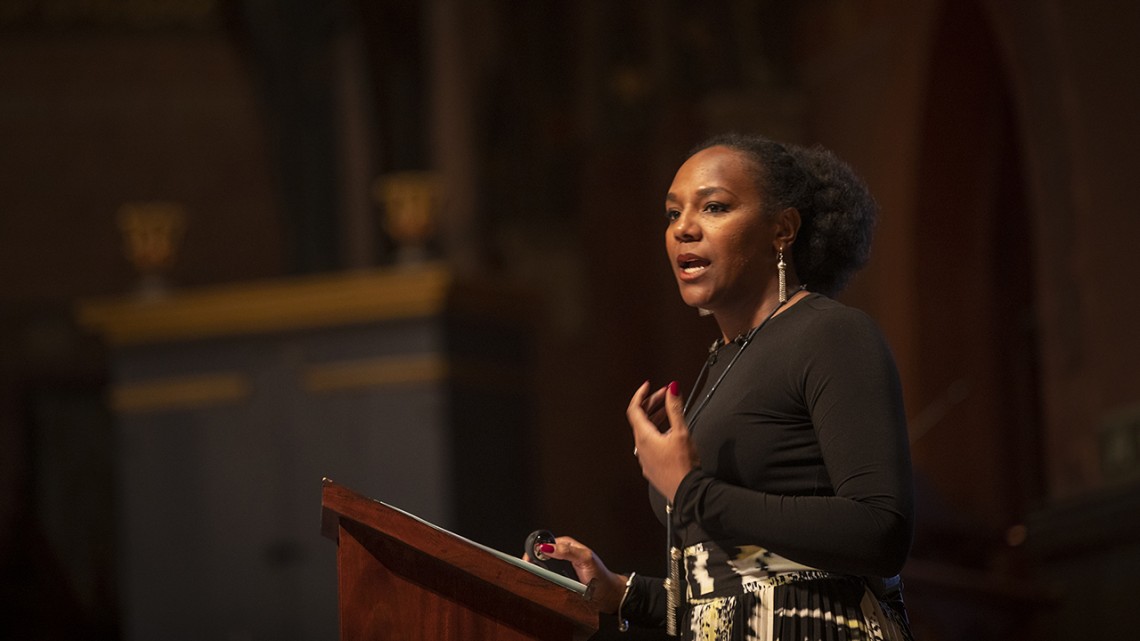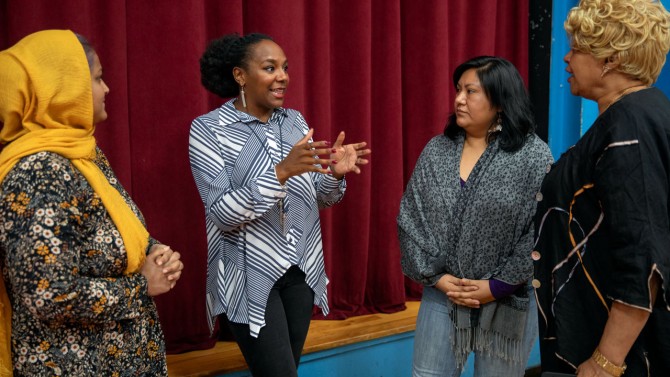
Filmmaker Bree Newsome delivers the annual Martin Luther King Jr. Commemorative Lecture Feb. 11 in Sage Chapel.
Bree Newsome: 'Everyone has a role to play'
By Daniel Aloi
Bree Newsome may be the one known for removing the Confederate battle flag from a flagpole on the South Carolina Statehouse grounds in 2015, but she wasn’t alone.
“Sometimes people feel powerless and overwhelmed by it all,” the filmmaker and activist said Feb. 11, delivering Cornell’s annual Martin Luther King Jr. Commemorative Lecture in Sage Chapel. “One doesn’t have to be a frontline activist … Everyone in the community has a role to play in transforming our community. Everyone must ask themselves, what is at stake in these times?”
The Confederate flag, installed at the statehouse in 1961, had been criticized for decades, Newsome said, and it remained “an ominous symbol” of racism. When nine African-American parishioners were murdered by a white supremacist in 2015 at a church in Charleston, South Carolina, “there was a renewed sense of outrage over the state’s continued endorsement of this hate symbol,” she said.
The Rev. Clementa Pinckney, the church’s pastor and a state senator, was among those slain, and his body was brought to the state capitol.
“The United States and South Carolina state flags were lowered to half-staff, yet due to the law enacted in 2000, the Confederate flag remained high and fully unfurled even as Pinckney’s casket was carried through the streets of Columbia, South Carolina,” Newsome said. “The message they sent that day was clear, as it was on the day the all-white Legislature first raised the flag in 1961.”
Newsome and other activists met that week to plan an action to remove the flag.
“Though I’d become an organizer in my local community and I had no specific intention of getting arrested again – I’d made a promise to my parents after that first sit-in at the statehouse – I was so deeply convicted on this issue that I had seriously contemplated attempting to climb myself, having no climbing experience,” Newsome said.
A Greenpeace activist trained her to climb for a day and a half, she said. “Another activist tried to talk me out of going down there … but I felt so strongly that a statement had to be made about how absolutely intolerable it was for that flag to fly another day in that manner.”
After scaling the flagpole and taking down the flag, Newsome was arrested with fellow activist James Tyson on June 27, 2015. The state Legislature voted to remove the flag permanently less than three weeks later.
“We succeeded in challenging a whole symbol of segregation and created a new image of liberation,” she said. “The fact is that symbols themselves don’t make reality the way it is. The fact of the flag flying over the statehouse for 54 years was not the thing that kept black Americans in South Carolina oppressed. The flag symbolized the oppression. To effect real change, we must end policies that perpetuate racial disparity and injustice.”
Newsome also spoke to community members at a luncheon Feb. 11 at the Greater Ithaca Activities Center. She was introduced by Marla Love, Cornell senior associate dean of students for diversity and equity.
“The thing everybody asks me is, ‘Why did you climb the pole?’ ‘What were all the things that led to that moment?’” she said.
Newsome recounted her upbringing and credited her parents, both educators. “I never said to myself, ‘I’m going to be an activist.’ I aspired to be an artist,” she said.
Newsome said she was a “hashtag activist” after college and became more active during President Barack Obama’s first term. After the killing of teenager Trayvon Martin in Florida in 2012 and “the U.S. Supreme Court struck down key parts of the Voting Rights Act” in 2013, she said, “I thought it was really important to draw attention to what was going on.”
She said it’s important for teens interested in social justice to know that much of the mass civil disobedience during the civil rights movement was organized and led by young people. “There’s no reason for them to think that they don’t have a place in the forefront of things now.”
“The older I get, the more I try to see what I am doing to help uplift and empower those 10, 15 years younger than me,” she said, “to help them realize that they have a voice and they have a say.”
Media Contact
Get Cornell news delivered right to your inbox.
Subscribe

